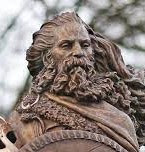Till about the Year of Grace 860 there were no kings in Norway, nothing but numerous jarls, essentially kinglets, each presiding over a kind of republican or parliamentary little territory.
The Norwegians always have regarded Harald I ‘Fairhair’ Halfdanson (c. 850-933) son of Halfdan ‘the Black’ as a legendary founder of the Norwegian kingdom who firstly unified petty kingdoms into a single kingdom of Norway.
At the assent of the child king Harald in 862, local rivals rebelled and invaded Harald’s territories, but due to the help of his maternal uncle Guttorm, Harald drove back the invaders and secured domination over the local lords and kings. The business of conquest lasted Harald about twelve years (A.D. 860-872), in which he subdued also the Vikings of the out-islands, Orkneys, Shetlands, Hebrides, and Man. Sixty more years were given him to consolidate and regulate what he had conquered.
After King Harald had subdued the whole land, he was one day at a feast in More, given by Earl Ragnvald. Then King Harald went into a bath, and had his hair dressed. Earl Ragnvald now cut his hair, which had been uncut and uncombed for ten years; and therefore, the king had been called Lufa (i.e., with rough matted hair). But then Earl Ragnvald gave him the distinguishing name Harald Harfager (i.e., fair hair).
King Harald married most of his daughters within the country to his earls, and from them many great families are descended. Harald died on a bed of sickness in Hogaland (A.D. 933), and was buried under a mound at Haugar in Karmtsund.
Harald Fairhair – First King of Norway
The Rise, Fall, and Rebirth of Electronic Commerce
-
The modern era of electronic commerce, or e-commerce, can be traced back to
October 1994, when the first version of the Netscape browser was released
to ...




